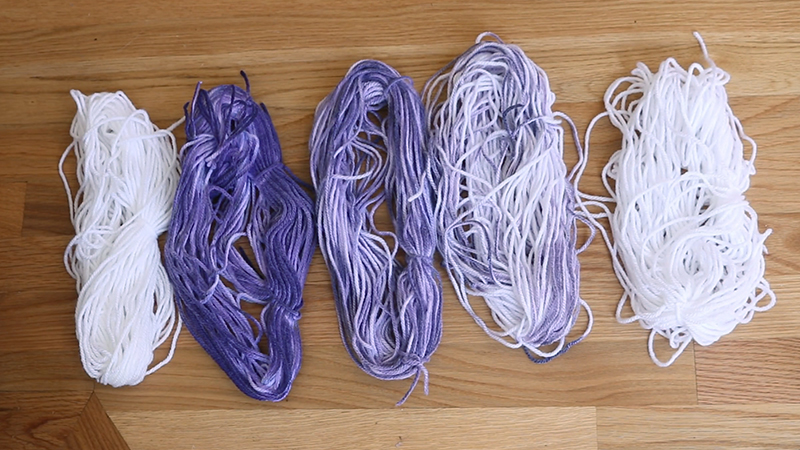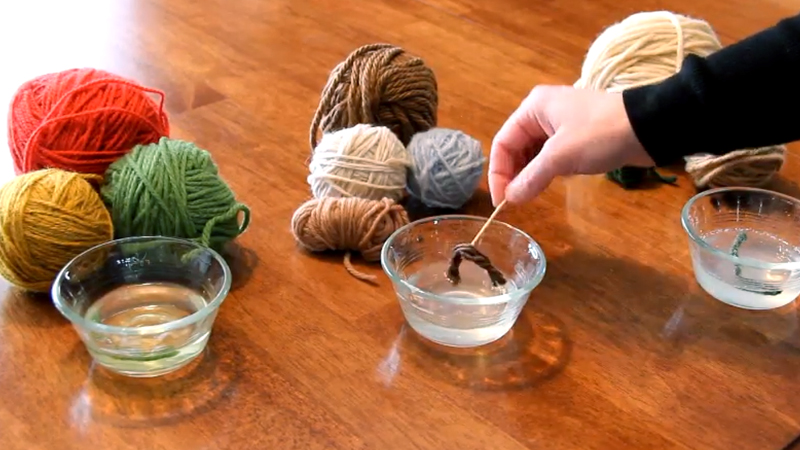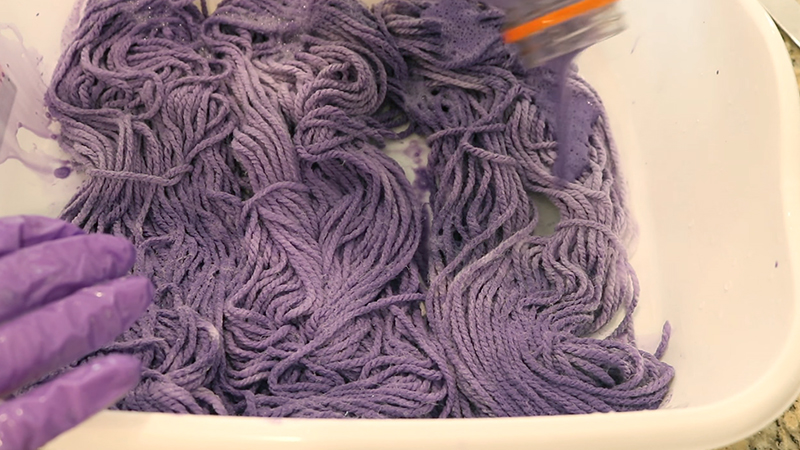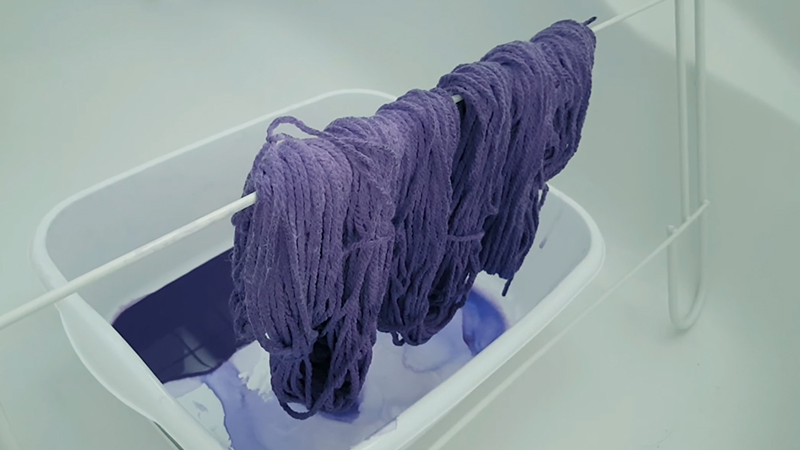Bleaching acrylic yarn can be a transformative process, allowing crafters and artisans to create unique textures and colors.
However, it’s a delicate endeavor that requires careful consideration to achieve the desired results without compromising the yarn’s integrity. Acrylic yarn, being a synthetic fiber, responds differently to bleaching compared to natural materials.
This introduction explores the feasibility and intricacies of bleaching acrylic yarn. We will delve into the methods, safety measures, and alternatives to help you unlock the creative potential of acrylic yarn while preserving its quality.
Whether you seek to lighten, customize, or rejuvenate your acrylic yarn projects, understanding the process is essential for successful outcomes.

What Is Acrylic Yarn?
Acrylic yarn is a synthetic fiber commonly used in knitting and crocheting. It’s composed of polymer strands made from acrylonitrile, a petroleum-based compound. Acrylic yarn is favored for its affordability, durability, and versatility.
It closely mimics the softness and appearance of natural fibers like wool, making it an excellent choice for creating warm, lightweight, and easy-to-care-for garments, blankets, and accessories.
Unlike natural fibers, acrylic yarn is resistant to moisture, mildew, and moths, making it a practical option for everyday use. Additionally, it comes in a wide range of colors and is often used for crafting and projects where vibrant, long-lasting hues are desired.
Its synthetic nature also means it’s typically hypoallergenic, making it suitable for individuals with wool sensitivities.
Can You Bleach Acrylic Yarn?
Yes. Bleaching acrylic yarn is possible, but it’s important to approach the process with caution.
Acrylic yarn is a synthetic material made from polymers, and it reacts differently to bleaching compared to natural fibers like cotton or wool.
Here’s a detailed explanation of how to bleach acrylic yarn:
Materials Needed:
- Acrylic Yarn.
- Bleach.
- Water.
- Plastic Container.
- Gloves.
- Protective Eyewear.
- Ventilation.
- pH Neutral Soap.
- Towels or Rags.
Steps:
Safety First
Ensure you’re wearing the appropriate protective gear, including gloves and eyewear, throughout the entire process. In case of accidental contact with bleach, promptly rinse the affected area with copious amounts of water.
Work in an area with good ventilation to minimize inhalation of any fumes.
Preparing the Bleach Solution
Gradually add the bleach to the water, stirring gently. Take care not to inhale any fumes produced during this process. Aim for a solution that is slightly milder than you might initially think, as acrylic fibers are sensitive to bleach.
Testing a Sample
Choose a small, inconspicuous piece of yarn for the initial test. This test allows you to observe how the specific yarn reacts to the bleach. Take note of any changes in color, texture, or strength.
The Bleaching Process
While the yarn is immersed in the bleach solution, observe it closely. Factors such as the original color of the yarn, its thickness, and the concentration of the bleach solution will all influence how quickly the yarn lightens. Be patient and attentive during this stage.
Monitoring Progress
Regularly check the yarn for the desired level of lightening. This step requires careful attention, as overexposure to bleach can weaken the fibers. If the desired effect is achieved, remove the yarn from the solution promptly.
Thorough Rinsing
After removing the yarn from the bleach solution, rinse it thoroughly in cold water. Ensure that all traces of bleach are completely removed.
A pH-neutral soap can be used to aid in this process. This step is crucial to prevent any residual bleach from weakening the fibers over time.
Drying the Yarn
Gently lay the yarn flat on a clean towel or cloth in a well-ventilated area. Allow it to air dry naturally. Avoid using a dryer or wringing out the yarn, as this could cause damage to the fibers. Take care to ensure the yarn is evenly spread out for even drying.
Why You Should Avoid Chlorine Bleach for Acrylic Yarn

Chlorine bleach, commonly used for laundry purposes, can be detrimental to acrylic yarn for several reasons:
Chemical Reaction
Acrylic yarn is a synthetic material made from polymers. When exposed to chlorine bleach, the chemical composition of the acrylic fibers can be altered, leading to weakening, brittleness, and potential degradation of the yarn.
Color Alteration
Chlorine bleach can cause drastic color changes in acrylic yarn, often resulting in unwanted discoloration or even complete loss of the original color. This can be unpredictable and difficult to control.
Fiber Weakness
Chlorine bleach can weaken the fibers of acrylic yarn over time. This makes the yarn more susceptible to fraying, breaking, and overall reduced durability.
Potential Residue
It can be challenging to thoroughly rinse out all traces of chlorine bleach from acrylic yarn. Even small amounts of residual bleach can continue to weaken the fibers over time, potentially leading to premature wear and tear.
Long-Term Damage
The effects of chlorine bleach on acrylic yarn may not be immediately noticeable. However, over time, the weakened fibers may become more prone to damage from normal wear and washing.
Alternative Ways to Bleach Acrylic Yarn

There are alternative methods to bleach acrylic yarn that are gentler and less likely to cause damage to the fibers.
Here are some effective options:
Hydrogen Peroxide
Hydrogen peroxide is a mild and safe alternative to chlorine bleach. Mix equal parts of hydrogen peroxide and water in a container.
Submerge the acrylic yarn in the solution, ensuring it’s evenly soaked. Periodically check the progress, as hydrogen peroxide works gradually.
Once the desired lightening effect is achieved, remove the yarn and rinse it thoroughly with cold water to halt the bleaching process. This method is less harsh on the fibers compared to chlorine bleach and is suitable for achieving a subtle lightening effect.
Lemon Juice
Lemon juice is a natural and eco-friendly bleaching agent. Dilute fresh lemon juice with an equal amount of water in a container. Immerse the yarn, making sure it’s fully saturated.
Place the container in direct sunlight, as the combination of lemon juice and sunlight enhances the bleaching effect. Monitor the progress and once the desired lightening is achieved, rinse the yarn thoroughly with cold water.
The acidity of the lemon juice helps break down stains and discolorations, making it an effective alternative for acrylic yarn.
Baking Soda
Baking soda is a versatile cleaning agent that can help remove stains and brighten colors in acrylic yarn. Create a paste by mixing baking soda with a small amount of water. Gently rub the paste onto the stained or discolored areas of the yarn.
Allow it to sit for a short period before rinsing it with cold water. This method is particularly effective for spot treatments and can refresh the appearance of the yarn without harsh chemicals.
Color Remover
Color removers specifically formulated for synthetic fibers are a safe and reliable option for lightening acrylic yarn.
Follow the manufacturer’s instructions carefully, as each product may have specific dilution ratios and soaking times. This method is designed to effectively remove color without compromising the integrity of the yarn’s fibers.
Oxygen Bleach
Oxygen bleach, often found in laundry detergents labeled as color-safe or non-chlorine bleach, is a gentle option for lightening acrylic yarn.
Dilute the oxygen bleach according to the manufacturer’s instructions and soak the yarn. Monitor the progress, and once the desired effect is achieved, rinse the yarn thoroughly with cold water.
This method is designed to be less harsh than chlorine bleach, making it suitable for synthetic fibers like acrylic.
Vinegar
White vinegar is a natural and cost-effective option for brightening and refreshing acrylic yarn. Add a cup of white vinegar to a basin of water and submerge the yarn. Allow it to soak for a period of time, periodically checking the progress.
Once the desired effect is achieved, rinse the yarn thoroughly with cold water. Vinegar is mildly acidic, which can help break down residue and refresh the appearance of the yarn.
Tips for Bleaching Acrylic Yarn

Bleaching acrylic yarn can open up a world of creative possibilities, allowing you to achieve unique colors and effects. However, it’s important to approach this process with care and precision.
Here are some valuable tips to ensure your bleaching endeavor is successful while safeguarding the integrity of the yarn:
Proceed with Caution
When considering bleaching acrylic yarn, it’s important to approach the process with care and patience. Acrylic yarn is a synthetic fiber, and it reacts differently to bleach than natural fibers. So, take your time and follow these tips for a successful outcome.
Test a Small Sample
Before treating an entire skein or garment, conduct a test on a small, inconspicuous piece of yarn. This helps you gauge how the specific yarn reacts to the bleaching process and prevents potential damage to your project.
Choose a Milder Bleach
Opt for milder bleaching agents like hydrogen peroxide, lemon juice, or oxygen bleach instead of chlorine bleach. These alternatives are gentler on acrylic fibers and offer more control over the lightening process.
Dilute the Bleach
When preparing the bleach solution, gradually add the bleach to water. Start with a mild concentration and increase if necessary. Avoid using strong or concentrated bleach to minimize potential damage.
Monitor Progress Actively
While the yarn is soaking in the bleach solution, keep a close eye on its progress. Factors like yarn thickness and the initial color will influence how quickly the yarn lightens.
Remove the yarn from the solution as soon as you achieve the desired effect to prevent overexposure.
Rinse Thoroughly
After bleaching, rinse the yarn thoroughly in cold water to remove all traces of bleach. This step is crucial to prevent any residual bleach from weakening the fibers over time. Consider using a pH-neutral soap for a thorough cleaning.
Air Dry Carefully
Lay the yarn flat on a clean towel or cloth in a well-ventilated area to air dry. Avoid using a dryer or wringing out the yarn, as this can damage the fibers. Ensure the yarn is evenly spread out for uniform drying.
Safety First
Always prioritize safety by wearing gloves and protective eyewear while handling bleach. Work in a well-ventilated area to minimize fumes, and follow safety guidelines for the specific bleach or alternative method you choose.
Document Your Process
Keep a record of the bleach concentration, soaking time, and any other relevant details during the bleaching process. This documentation can be helpful if you need to replicate the results in the future.
Be Patient and Experiment
Achieving the desired lighting effect may require multiple attempts or adjustments to your approach. Be patient and open to experimenting with different methods and concentrations until you achieve the look you want.
FAQs
Can I bleach acrylic yarn to change its color?
Yes, you can bleach acrylic yarn to lighten or alter its color. However, it’s important to proceed with caution and test a small sample first.
What alternative methods can I use for bleaching acrylic yarn?
Alternative methods include using hydrogen peroxide, lemon juice, baking soda, color removers, and oxygen bleach. These options are gentler on acrylic fibers than chlorine bleach.
Is it safe to bleach acrylic yarn at home?
Yes, it’s safe to bleach acrylic yarn at home, but it requires careful handling of chemicals and adherence to safety precautions, such as wearing gloves and protective eyewear.
How can I avoid damaging the acrylic yarn while bleaching?
To avoid damage, use a milder bleach or alternative, perform a small test first, monitor the process closely, and rinse the yarn thoroughly after bleaching.
Can I use bleach to remove stains from acrylic yarn?
Bleach can be used to remove stains from acrylic yarn, but it’s important to dilute it appropriately and rinse thoroughly to prevent fiber damage.
Wrap Up
Bleaching acrylic yarn is a nuanced process that demands both precision and care. Understanding the unique properties of this synthetic fiber is crucial for achieving desired results.
Through alternative methods like hydrogen peroxide, lemon juice, or oxygen bleach, crafters can lighten and customize acrylic yarn while preserving its integrity.
Remember, safety precautions are paramount, and experimentation may be necessary to attain the perfect outcome. Documenting your process ensures reproducibility.
With patience and diligence, bleaching acrylic yarn opens up a realm of creative possibilities, allowing you to craft distinctive and eye-catching projects.
Embrace this technique as a means to bring your artistic vision to life while working with this versatile material.
Leave a Reply